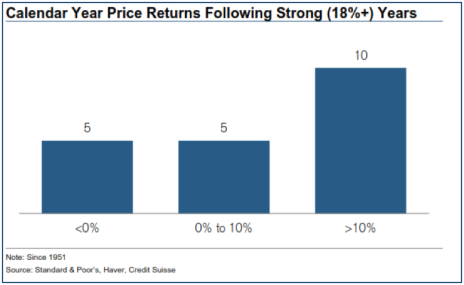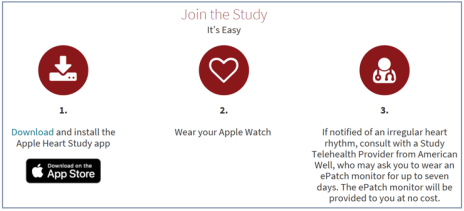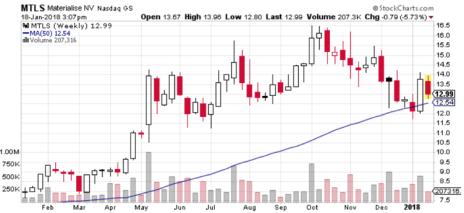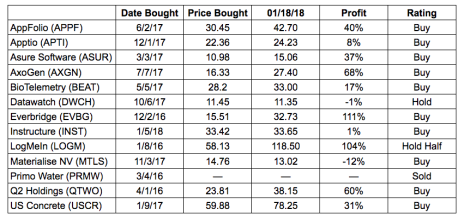I spent a good portion of this past week working on my 2018 Small-Cap Outlook. We’ll be publishing that soon, but I wanted to share a few thoughts from it today, starting with my year-end target for the S&P 600 Small Cap Index.
My best guess is that the S&P 600 is up 12% to 17% in 2018.
How do I get there?
The same way I get to every year-end value! By applying what I think is a reasonable (for the times) forward P/E ratio to expected EPS. My 2018 year-end target range of 1,045 to 1,100 implies that the S&P 600 Small Cap index will be trading with a forward P/E of 19 to 20 when the year ends. That’s about the same forward P/E the index trades at today. And I’m using the current consensus EPS estimate for 2019, which is $54.95.
There’s a lot that can be considered when trying to come up with a year-end target. But it’s also easy to get buried in the weeds, so I try to focus on what I think matters most. And one data point that does a good job of summarizing why stocks (small, mid and large caps) should be up this year is shown in the image below (courtesy of Credit Suisse). It shows the stock market’s (i.e., S&P 500) range of returns in years following an 18% or more gain since 1951.
The S&P 500 was up 19.4% in 2017. And the data shows that over the last 67 years, 18%-plus returns have occurred 20 times. Five times, the market’s next year return was negative, five times it was 0% to 10%, and 10-times it was 10% or more.
The punch line is that three quarters of the time the market was up, and half of the time it was up 10% or more. If the S&P 500 delivers as it historically has, I expect small caps will do even better.
As of mid-January 2018, stocks are up. Small caps are up 2.7%, and large caps are up 4.7%. While I’m sure we’ll have periods of volatility and potentially painful corrections in 2018 (possibly soon with earnings season just starting), the bull market appears to be alive and well!
Updates
AppFolio (APPF) continues to consolidate in the 40 to 43 range, where it’s been trading since the beginning of December. We haven’t received an earnings release date yet, but I suspect we’re looking at a date in mid-February. Last year (2017) is expected to be a breakthrough year in terms of profitability, with consensus estimates calling for EPS of $0.41, a huge improvement from a loss of $-0.12 in 2016. Revenue growth is expected to be around 34%. Perhaps more important than beating those numbers by a wide margin will be guiding for better-than-expected growth in 2018. The market currently expects revenue growth of 26.5% (I think 30% is more likely) and adjusted EPS growth of 32% (to $0.54, but I think $0.80, or more, is a better guess).
While the company has a relatively efficient business model driving faster than expected earnings growth in recent years, I think the market is wondering what’s next. AppFolio has made good progress growing its Property Management solution, but its Legal solution is still relatively small (<10% of revenue). To get that product cranking will likely require significant investment. As will expanding into a third vertical, whether that’s through acquisition or internal development (assuming the company wants to, which isn’t necessarily a given at this point). I also think there is some frustration on the part of analysts around disclosures, including details on sales force productivity, customer churn, future profit margin guidance, plans for new products, etc. This is a give and take business, and if management doesn’t give analysts enough to go on, they’ll plug conservative numbers into their models, which will spit out conservative price targets. On the other hand, sometimes it’s best to subscribe to the Bill Belichick/Patriots way. Which is to basically give the market nothing, then go out and crush the competition! The market will value the latter, provided AppFolio executes. BUY.
Apptio (APTI) continues to look terrific. The company sells Technology Business Management (TBM) solutions, which help CIOs do a better job of running their businesses. The easiest way to describe TBM is as an IT department’s software equivalent to finance’s ERP platform, human resources’ HRM platform and sales’ CRM platform. With data showing that companies expect to increase spending on technology solutions, the backdrop for Apptio looks good. Keeping at Buy. BUY.
Earnings: February 5
Asure Software (ASUR) picked up three more companies a few weeks ago and the market appears to approve. The stock, which was in the dumps in the fall of 2017, jumped back above 12 in mid-November, and has been trading in the 14 to 15.5 range for the last two months. Management presented at the Needham Growth Conference this week, but based on the slideshow, I didn’t see much new information. Keeping at Buy. BUY.
AxoGen (AXGN) dipped last week but has stabilized above its 50-day line. The company will report Q4 2017 results on February 28, but the focus of that event will likely be more on product development plans than financial results since management pre-released results last week. It said revenue should be up 45% to $16.5 million ($15.7 million was expected) with full-year revenue coming in around $60 million (up around 46%). Management also said that 2018 revenue should be up at least 40%, with gross margins above 80%. No EPS guidance was given, but consensus estimates currently call for a loss of around $-0.17 next year. I think you can buy this dip. BUY.
BioTelemetry (BEAT) has been looking better and better since shares turned around at 24 in mid-November. The stock is up roughly 38% since then, and is up 10% over the last six sessions. There’s a lot cooking here, from the integration of the LifeWatch acquisition to the Apple Heart (irregular heart rhythms) and Onduo (diabetes) studies. The second two are particularly interesting since they help move the story from one that’s more clinical in nature to one that’s increasingly consumer-oriented. If you own an Apple Watch, you can participate in the Apple Watch Study (image below from Stanford Medicine’s website).
While you never know how things will turn out, this stock has the feeling of one that could blow up. Let’s just say that 10 years from now the Apple Watch has really caught on, as have other wearable technologies, and BioTelemetry is powering the software and monitoring centers that help people detect and manage abnormal heart rhythms, blood glucose levels and more. It could be huge. In the meantime, they have a pretty good business to run too! BUY.
Datawatch (DWCH) hasn’t moved much since it gapped up following a Reuters report a few weeks back that said the company has hired a financial advisor after receiving acquisition interest. News flow has been quiet since, but Datawatch is set to report fiscal Q1 2018 results next Thursday after the bell. Consensus estimates are calling for around 13% revenue growth and EPS of $-0.02. More interesting will be discussion around acquisition interest, progress selling the new cloud-based enterprise solution, Swarm, progress transitioning customers’ subscription pricing plans, and full-year guidance for 2018. We’re already in the stock and the stakes are relatively high right now, so I’m keeping at Hold. If management declines to talk about acquisition interest (which is likely since there’s no reason they would want to share their hand), shares could easily pull back. On the other hand, perhaps a deal gets done and is announced at earnings? HOLD.
Earnings: January 25
Everbridge (EVBG) still looks good. No fundamental updates on the company, which sells critical communications software. The stock broke out above its previous high early last week and is still trending up. Keeping at Buy. BUY.
Earnings: February 2
Instructure (INST) is a cloud-based software company that serves the education and corporate markets with learning management software. The company was my January addition, and is trading around the same price as it was when I added it. Management presented at the Needham Growth Conference on Wednesday (replay is available on the investor relations segment of its website). Management slammed competitor Blackboard (again), saying the company’s new higher education cloud-based product will be roughly 18 months delayed, which pushes back any competitive threat through another academic buying cycle. Management also talked about the K-12 market, and said Blackboard and D2L don’t do as well as Instructure in this market because they lack cloud-based solutions, which is really what the K-12 market needs. And that Instructure’s new solution for this market, the assessment management system (AMS) Gauge, is designed to fit the testing needs that all schools must deal with. As far as the new corporate solution, Bridge, management confirmed that this system will ultimately have five modules: (1) Recruiting & Onboarding, (2) Learning, (3) Performance Management, (4) Compensation and (5) Career and Succession Management. It currently has the first three modules on the market, and plans to roll out the next two within the next three years. It’s a good story, and the stock is still in my buy range. BUY.
LogMeIn (LOGM) has been trading in a choppy pattern for several months, but when you step back, you see that the general trend remains up. We’re up around 106%. Keep holding. HOLD HALF.
Materialise (MTLS) can be a frustrating stock to own if you follow its price action too closely. It’s relatively thinly traded, and tends to bounce around a lot. This has been the case for a while, so if you’re looking at the stock’s chart, it can be helpful to switch the period from “daily” to “weekly.” That’s what is shown below, and you can see that the stock is trading around its 50-day line.
Management will present at the Needham Growth Conference this week, but I haven’t seen any slides or a link to a webcast (yet). Keeping at Buy. BUY.
Primo Water (PRMW). No Update. Sold last Friday for a 47% gain. SOLD.
Q2 Holdings (QTWO) dipped back below its 200-day line last week but has begun to make up some of the difference after five days in the black. No fundamental updates and no change in my rating. BUY.
Earnings: February 14
U.S. Concrete (USCR) pulled back to just below its 50-day line this week but that’s not necessarily a trend-breaker. Shares have done this roughly once a month since August, but the long-term trend is still heading in the right direction. Keeping at Buy. BUY.






